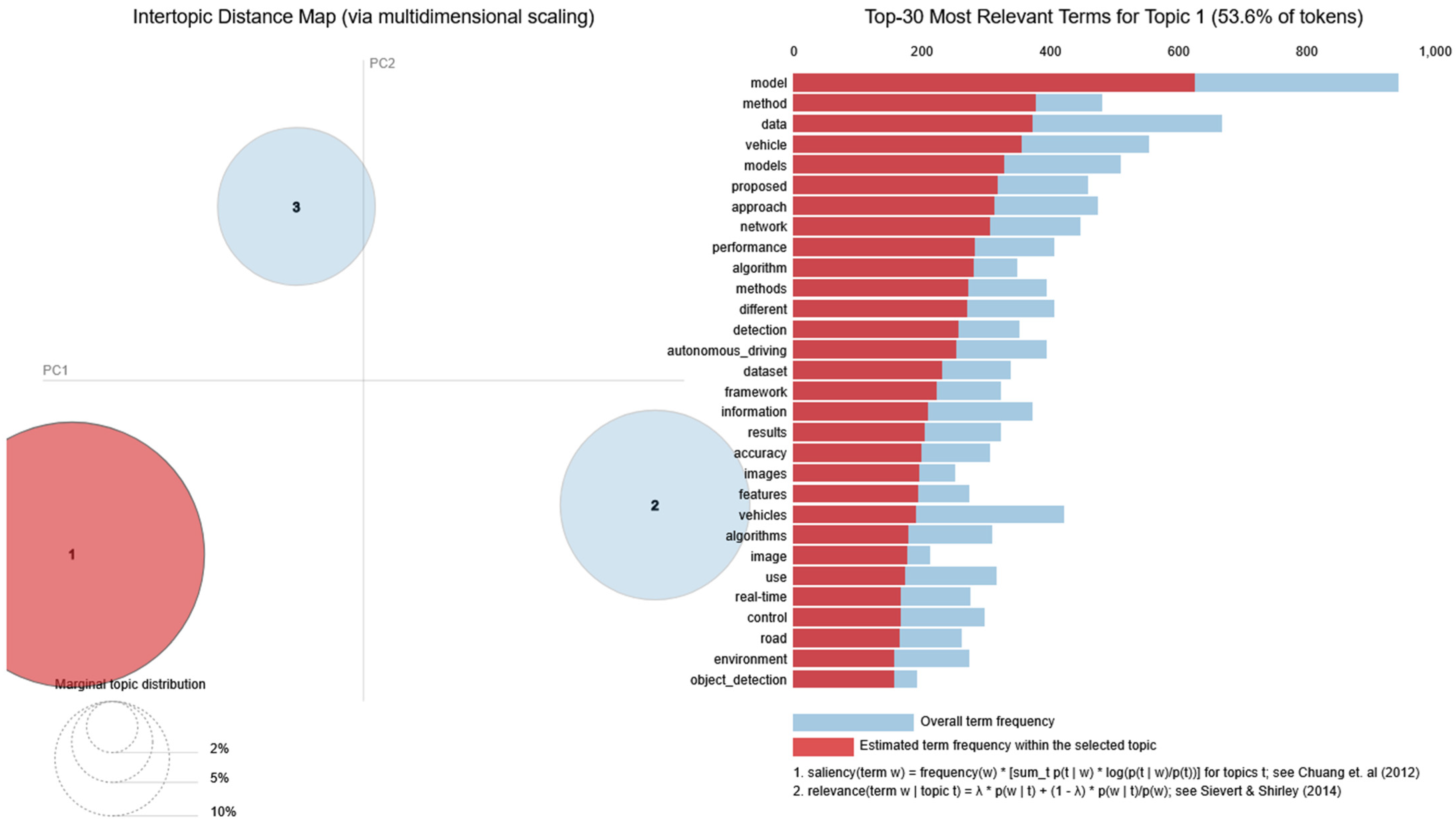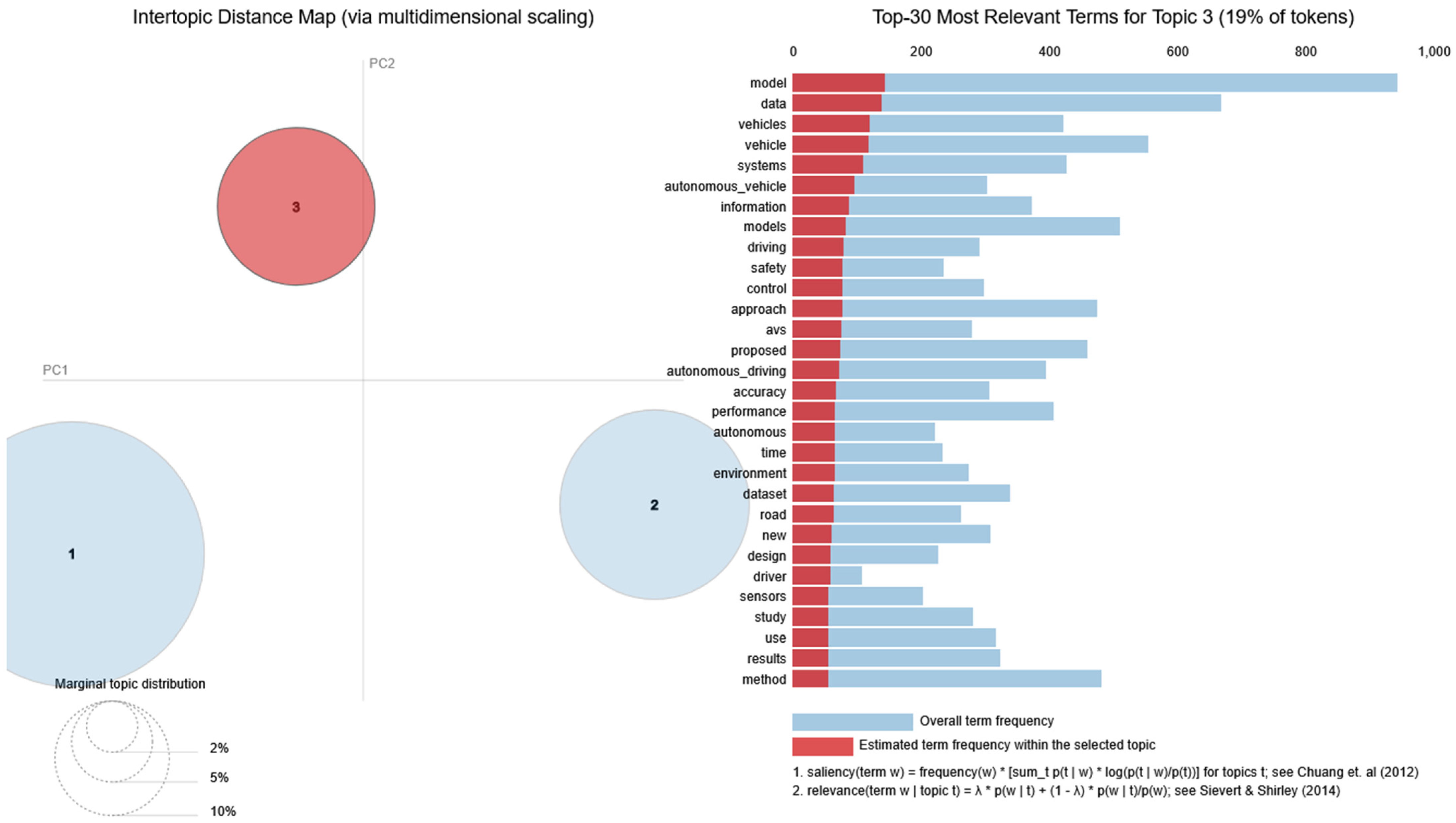The Road to Autonomy: A Systematic Review Through AI in Autonomous Vehicles
Abstract
1. Introduction
- SQ1: What topics are addressed in the top 10 most cited documents?
- SQ2: How do themes in AV, AI, ML, and DL evolve over time?
- SQ3: What are the core topics revealed through LDA and BERTopic?
- SQ4: What are the main findings, challenges, and research gaps identified in the literature at the intersection of AI and autonomous vehicles?
2. Materials and Methods
- Conference Proceedings Citation Index—Science (CPCI-S)—1990—present;
- Current Chemical Reactions (CCR-Expanded)—2010—present;
- Emerging Sources Citations Index (ESCI)—2005—present;
- Social Sciences Citation Index (SSCI)—1975—present;
- Book Citation Index—Social Sciences and Humanities (BKCI-SSH)—2010—present;
- Arts and Humanities Citation Index (A&HCI)—1975—present;
- Index Chemicus (IC)—2010—present;
- Science Citation Index Expanded (SCIE)—1900—present;
- Book Citation Index—Science (BKCI-S)—2010—present;
- Conference Proceedings Citation Index—Social Sciences and Humanities (CPCI-SSH)—1990—present;
3. Results
3.1. Dataset Description
3.2. Review of Top 10 Most Cited Articles
3.3. Thematic Maps and Themes Evolution
3.4. Topics Discovery Through LDA and BERTopic
3.5. Systematic Review Based on the Identified Topics
3.5.1. Perception and Object Detection
3.5.2. Driving Models, Decision-Making, and Control Systems
3.5.3. Human Factors, Ethics, and Societal Impact
3.5.4. Safety, Cybersecurity, and Robustness
3.5.5. Applications, Deployment, and Technological Development
4. Discussion and Limitations
4.1. Comparison in Terms of Identified Themes
4.2. Limitations
5. Conclusions
Supplementary Materials
Author Contributions
Funding
Data Availability Statement
Acknowledgments
Conflicts of Interest
References
- Faisal, A.; Kamruzzaman, M.; Yigitcanlar, T.; Currie, G. Understanding Autonomous Vehicles: A Systematic Literature Review on Capability, Impact, Planning and Policy. J. Transp. Land Use 2019, 12, 45–72. [Google Scholar] [CrossRef]
- Duarte, F.; Ratti, C. The Impact of Autonomous Vehicles on Cities: A Review. J. Urban Technol. 2018, 25, 3–18. [Google Scholar] [CrossRef]
- Ye, L.; Yamamoto, T. Evaluating the Impact of Connected and Autonomous Vehicles on Traffic Safety. Phys. A Stat. Mech. Appl. 2019, 526, 121009. [Google Scholar] [CrossRef]
- Zmud, J.P.; Sener, I.N. Towards an Understanding of the Travel Behavior Impact of Autonomous Vehicles. Transp. Res. Procedia 2017, 25, 2500–2519. [Google Scholar] [CrossRef]
- Miglani, A.; Kumar, N. Deep Learning Models for Traffic Flow Prediction in Autonomous Vehicles: A Review, Solutions, and Challenges. Veh. Commun. 2019, 20, 100184. [Google Scholar] [CrossRef]
- Fagnant, D.J.; Kockelman, K.M. The Travel and Environmental Implications of Shared Autonomous Vehicles, Using Agent-Based Model Scenarios. Transp. Res. Part C Emerg. Technol. 2014, 40, 1–13. [Google Scholar] [CrossRef]
- Fagnant, D.J.; Kockelman, K.M. Dynamic Ride-Sharing and Fleet Sizing for a System of Shared Autonomous Vehicles in Austin, Texas. Transportation 2018, 45, 143–158. [Google Scholar] [CrossRef]
- Liu, F. Retrieval Strategy and Possible Explanations for the Abnormal Growth of Research Publications: Re-Evaluating a Bibliometric Analysis of Climate Change. Scientometrics 2023, 128, 853–859. [Google Scholar] [CrossRef] [PubMed]
- Liu, W. The Data Source of This Study Is Web of Science Core Collection? Not Enough. Scientometrics 2019, 121, 1815–1824. [Google Scholar] [CrossRef]
- KeyWords Plus Generation, Creation, and Changes. Available online: https://support.clarivate.com/ScientificandAcademicResearch/s/article/KeyWords-Plus-generation-creation-and-changes?language=en_US (accessed on 1 November 2024).
- Domenteanu, A.; Cotfas, L.-A.; Diaconu, P.; Tudor, G.-A.; Delcea, C. AI on Wheels: Bibliometric Approach to Mapping of Research on Machine Learning and Deep Learning in Electric Vehicles. Electronics 2025, 14, 378. [Google Scholar] [CrossRef]
- Domenteanu, A.; Cibu, B.; Delcea, C.; Cotfas, L.-A. The World of Agent-Based Modeling: A Bibliometric and Analytical Exploration. Complexity 2025, 2025, 2636704. [Google Scholar] [CrossRef]
- Panait, M.; Cibu, B.R.; Teodorescu, D.M.; Delcea, C. European Fund Absorption and Contribution to Business Environment Development: Research Output Analysis Through Bibliometric and Topic Modeling Analysis. Businesses 2025, 5, 45. [Google Scholar] [CrossRef]
- Cotfas, L.-A.; Sandu, A.; Delcea, C.; Diaconu, P.; Frăsineanu, C.; Stănescu, A. From Transformers to ChatGPT: An Analysis of Large Language Models Research. IEEE Access 2025, 13, 146889–146931. [Google Scholar] [CrossRef]
- Crișan, G.-A.; Domenteanu, A.; Popescu, M.E.; Delcea, C. Decision-Making for Sustainable Digitalization Through Grey Systems Theory: A Bibliometric Overview. Sustainability 2025, 17, 4615. [Google Scholar] [CrossRef]
- Sandu, A.; Diaconu, P.; Delcea, C.; Domenteanu, A. Emphasizing Grey Systems Contribution to Decision-Making Field Under Uncertainty: A Global Bibliometric Exploration. Mathematics 2025, 13, 1278. [Google Scholar] [CrossRef]
- Domenteanu, A.; Diaconu, P.; Delcea, C. Bibliometric Insights into Time Series Forecasting and AI Research: Growth, Impact, and Future Directions. Appl. Sci. 2025, 15, 6221. [Google Scholar] [CrossRef]
- Sarkis-Onofre, R.; Catalá-López, F.; Aromataris, E.; Lockwood, C. How to Properly Use the PRISMA Statement. Syst. Rev. 2021, 10, 117. [Google Scholar] [CrossRef]
- Morooka, F.E.; Junior, A.M.; Sigahi, T.F.A.C.; Pinto, J.d.S.; Rampasso, I.S.; Anholon, R. Deep Learning and Autonomous Vehicles: Strategic Themes, Applications, and Research Agenda Using SciMAT and Content-Centric Analysis, a Systematic Review. Mach. Learn. Knowl. Extr. 2023, 5, 763–781. [Google Scholar] [CrossRef]
- Abbasi, S.; Rahmani, A.M. Artificial Intelligence and Software Modeling Approaches in Autonomous Vehicles for Safety Management: A Systematic Review. Information 2023, 14, 555. [Google Scholar] [CrossRef]
- Valle-Cruz, D.; Gil-Garcia, J.R.; Sandoval-Almazan, R. Chapter 1: Artificial Intelligence Algorithms and Applications in the Public Sector: A Systematic Literature Review Based on the PRISMA Approach. In Research Handbook on Public Management and Artificial Intelligence; Edward Elgar Publishing: Cheltenham, UK, 2024; ISBN 978-1-80220-734-7. [Google Scholar]
- Întorsureanu, I.; Oprea, S.-V.; Bâra, A.; Vespan, D. Generative AI in Education: Perspectives Through an Academic Lens. Electronics 2025, 14, 1053. [Google Scholar] [CrossRef]
- Grootendorst, M. BERTopic: Neural Topic Modeling with a Class-Based TF-IDF Procedure. arXiv 2022, arXiv:2203.05794. [Google Scholar]
- Delcea, C.; Oprea, S.-V.; Dima, A.M.; Domenteanu, A.; Bara, A.; Cotfas, L.-A. Energy Communities: Insights from Scientific Publications. Oeconomia Copernic. 2024, 15, 1101–1155. [Google Scholar] [CrossRef]
- Domenteanu, A.; Delcea, C.; Chiriță, N.; Ioanăș, C. From Data to Insights: A Bibliometric Assessment of Agent-Based Modeling Applications in Transportation. Appl. Sci. 2023, 13, 12693. [Google Scholar] [CrossRef]
- Řehůřek, R.; Sojka, P. Software Framework for Topic Modelling with Large Corpora. In Proceedings of the LREC 2010 Workshop on New Challenges for NLP Frameworks, Valletta, Malta, 17–23 May 2010. [Google Scholar] [CrossRef]
- Dresner, K.; Stone, P. A Multiagent Approach to Autonomous Intersection Management. J. Artif. Intell. Res. 2008, 31, 591–656. [Google Scholar] [CrossRef]
- Awad, E.; Dsouza, S.; Kim, R.; Schulz, J.; Henrich, J.; Shariff, A.; Bonnefon, J.-F.; Rahwan, I. The Moral Machine Experiment. Nature 2018, 563, 59–64. [Google Scholar] [CrossRef] [PubMed]
- Feng, D.; Haase-Schütz, C.; Rosenbaum, L.; Hertlein, H.; Gläser, C.; Timm, F.; Wiesbeck, W.; Dietmayer, K. Deep Multi-Modal Object Detection and Semantic Segmentation for Autonomous Driving: Datasets, Methods, and Challenges. IEEE Trans. Intell. Transp. Syst. 2021, 22, 1341–1360. [Google Scholar] [CrossRef]
- Mennel, L.; Symonowicz, J.; Wachter, S.; Polyushkin, D.K.; Molina-Mendoza, A.J.; Mueller, T. Ultrafast Machine Vision with 2D Material Neural Network Image Sensors. Nature 2020, 579, 62–66. [Google Scholar] [CrossRef]
- Xu, X.; Tan, M.; Corcoran, B.; Wu, J.; Boes, A.; Nguyen, T.G.; Chu, S.T.; Little, B.E.; Hicks, D.G.; Morandotti, R.; et al. 11 TOPS Photonic Convolutional Accelerator for Optical Neural Networks. Nature 2021, 589, 44–51. [Google Scholar] [CrossRef]
- Bescos, B.; Fácil, J.M.; Civera, J.; Neira, J. DynaSLAM: Tracking, Mapping, and Inpainting in Dynamic Scenes. IEEE Robot. Autom. Lett. 2018, 3, 4076–4083. [Google Scholar] [CrossRef]
- Schwarting, W.; Alonso-Mora, J.; Rus, D. Planning and Decision-Making for Autonomous Vehicles. Annu. Rev. Control Robot. Auton. Syst. 2018, 1, 187–210. [Google Scholar] [CrossRef]
- Arnold, E.; Al-Jarrah, O.Y.; Dianati, M.; Fallah, S.; Oxtoby, D.; Mouzakitis, A. A Survey on 3D Object Detection Methods for Autonomous Driving Applications. IEEE Trans. Intell. Transp. Syst. 2019, 20, 3782–3795. [Google Scholar] [CrossRef]
- Kuutti, S.; Bowden, R.; Jin, Y.; Barber, P.; Fallah, S. A Survey of Deep Learning Applications to Autonomous Vehicle Control. IEEE Trans. Intell. Transp. Syst. 2021, 22, 712–733. [Google Scholar] [CrossRef]
- Koopman, P.; Wagner, M. Autonomous Vehicle Safety: An Interdisciplinary Challenge. IEEE Intell. Transp. Syst. Mag. 2017, 9, 90–96. [Google Scholar] [CrossRef]
- Wilczewski, M.; Alon, I. Language and Communication in International Students’ Adaptation: A Bibliometric and Content Analysis Review. High Educ. 2023, 85, 1235–1256. [Google Scholar] [CrossRef] [PubMed]
- Azam, M.; Hassan, S.A.; Che Puan, O. Autonomous Vehicles in Mixed Traffic Conditions—A Bibliometric Analysis. Sustainability 2022, 14, 10743. [Google Scholar] [CrossRef]
- Chuang, J.; Manning, C.D.; Heer, J. Termite: Visualization techniques for assessing textual topic models. In AVI’12: Proceedings of the International Working Conference on Advanced Visual Interfaces, Capri Island, Italy, 21–25 May 2012; Association for Computing Machinery: New York, NY, USA, 2012; pp. 74–77. [Google Scholar]
- Sievert, C.; Shirley, K. LDAvis: A method for visualizing and interpreting topics. In Proceedings of the Workshop on Interactive Language Learning, Visualization, and Interfaces; Association for Computational Linguistics: Baltimore, MA, USA, 2014; pp. 63–70. [Google Scholar]
- Suprapto, B.Y.; Dwijayanti, S.; Hafiz, D.M.A.; Ardandy, F.A.; Jonathan, J. Designing an Autonomous Vehicle Using Sensor Fusion Based on Path Planning and Deep Learning Algorithms. SAIEE Afr. Res. J. 2024, 115, 86–98. [Google Scholar] [CrossRef]
- Thakur, A.; Mishra, S.K. An In-Depth Evaluation of Deep Learning-Enabled Adaptive Approaches for Detecting Obstacles Using Sensor-Fused Data in Autonomous Vehicles. Eng. Appl. Artif. Intell. 2024, 133, 108550. [Google Scholar] [CrossRef]
- Cao, J.; Zhang, H.; Jin, L.; Lv, J.; Hou, G.; Zhang, C. A Review of Object Tracking Methods: From General Field to Autonomous Vehicles. Neurocomputing 2024, 585, 127635. [Google Scholar] [CrossRef]
- Miao, Z.; Shao, C.; Li, H.; Cui, Y. Adaptive Attack Recognition Method Based on Probability Model for Autonomous Vehicle. Electron. Lett. 2024, 60, e13226. [Google Scholar] [CrossRef]
- Azam, S.; Munir, F.; Sheri, A.M.; Kim, J.; Jeon, M. System, Design and Experimental Validation of Autonomous Vehicle in an Unconstrained Environment. Sensors 2020, 20, 5999. [Google Scholar] [CrossRef]
- Ding, F.; Pan, Z.; Deng, Y.; Deng, J.; Lu, C.X. Self-Supervised Scene Flow Estimation With 4-D Automotive Radar. IEEE Robot. Autom. Lett. 2022, 7, 8233–8240. [Google Scholar] [CrossRef]
- Nie, L.; Wang, X.; Sun, W.; Li, Y.; Li, S.; Zhang, P. Imitation-Learning-Enabled Vehicular Edge Computing: Toward Online Task Scheduling. IEEE Netw. 2021, 35, 102–108. [Google Scholar] [CrossRef]
- Yoganathan, V.; Osburg, V.-S. Heterogenous Evaluations of Autonomous Vehicle Services: An Extended Theoretical Framework and Empirical Evidence. Technol. Forecast. Soc. Change 2024, 198, 122952. [Google Scholar] [CrossRef]
- Liu, J.; Park, J.-M. “Seeing Is Not Always Believing”: Detecting Perception Error Attacks Against Autonomous Vehicles. IEEE Trans. Dependable Secur. Comput. 2021, 18, 2209–2223. [Google Scholar] [CrossRef]
- Li, L.; Ota, K.; Dong, M. Humanlike Driving: Empirical Decision-Making System for Autonomous Vehicles. IEEE Trans. Veh. Technol. 2018, 67, 6814–6823. [Google Scholar] [CrossRef]
- Medrano-Berumen, C.; İlhan Akbaş, M. Validation of Decision-Making in Artificial Intelligence-Based Autonomous Vehicles. J. Inf. Telecommun. 2021, 5, 83–103. [Google Scholar] [CrossRef]
- Altay, B.C.; Boztas, A.E.; Okumuş, A.; Gul, M.; Çelik, E. How Will Autonomous Vehicles Decide in Case of an Accident? An Interval Type-2 Fuzzy Best–Worst Method for Weighting the Criteria from Moral Values Point of View. Sustainability 2023, 15, 8916. [Google Scholar] [CrossRef]
- Lei, T.; Luo, C.; Jan, G.E.; Bi, Z. Deep Learning-Based Complete Coverage Path Planning with Re-Joint and Obstacle Fusion Paradigm. Front. Robot. AI 2022, 9, 843816. [Google Scholar] [CrossRef] [PubMed]
- Cui, C.; Ma, Y.; Cao, X.; Ye, W.; Wang, Z. Receive, Reason, and React: Drive as You Say, with Large Language Models in Autonomous Vehicles. IEEE Intell. Transp. Syst. Mag. 2024, 16, 81–94. [Google Scholar] [CrossRef]
- Mahmood, T.; Idrees, A.; Hayat, K.; Ashiq, M.; ur Rehman, U. Selection of AI Architecture for Autonomous Vehicles Using Complex Intuitionistic Fuzzy Rough Decision Making. World Electr. Veh. J. 2024, 15, 402. [Google Scholar] [CrossRef]
- Le Mero, L.; Yi, D.; Dianati, M.; Mouzakitis, A. A Survey on Imitation Learning Techniques for End-to-End Autonomous Vehicles. IEEE Trans. Intell. Transp. Syst. 2022, 23, 14128–14147. [Google Scholar] [CrossRef]
- Simsek, M.; Boukerche, A.; Kantarci, B.; Khan, S. AI-Driven Autonomous Vehicles as COVID-19 Assessment Centers: A Novel Crowdsensing-Enabled Strategy. Pervasive Mob. Comput. 2021, 75, 101426. [Google Scholar] [CrossRef]
- Osório, A.; Pinto, A. Information, Uncertainty and the Manipulability of Artificial Intelligence Autonomous Vehicles Systems. Int. J. Hum.-Comput. Stud. 2019, 130, 40–46. [Google Scholar] [CrossRef]
- Zaboli, A.; Hong, J.; Kwon, J.; Moore, J. A Survey on Cyber-Physical Security of Autonomous Vehicles Using a Context Awareness Method. IEEE Access 2023, 11, 136706–136725. [Google Scholar] [CrossRef]
- Mechernene, A.; Judalet, V.; Chaibet, A.; Boukhnifer, M. Detection and Risk Analysis with Lane-Changing Decision Algorithms for Autonomous Vehicles. Sensors 2022, 22, 8148. [Google Scholar] [CrossRef] [PubMed]
- McCarroll, C.; Cugurullo, F. No City on the Horizon: Autonomous Cars, Artificial Intelligence, and the Absence of Urbanism. Front. Sustain. Cities 2022, 4, 937933. [Google Scholar] [CrossRef]
- McCarroll, C.; Cugurullo, F. Social Implications of Autonomous Vehicles: A Focus on Time. AI Soc. 2022, 37, 791–800. [Google Scholar] [CrossRef] [PubMed]
- Su, H.; Jia, Y. Study of Human Comfort in Autonomous Vehicles Using Wearable Sensors. IEEE Trans. Intell. Transp. Syst. 2022, 23, 11490–11504. [Google Scholar] [CrossRef]
- Cunneen, M.; Mullins, M.; Murphy, F. Autonomous Vehicles and Embedded Artificial Intelligence: The Challenges of Framing Machine Driving Decisions. Appl. Artif. Intell. 2019, 33, 706–731. [Google Scholar] [CrossRef]
- Tawfeek, M.H. Human-like Speed Modeling for Autonomous Vehicles during Car-Following at Intersections. Can. J. Civ. Eng. 2022, 49, 255–264. [Google Scholar] [CrossRef]
- Yang, J.; Zhang, J.; Xi, M.; Lei, Y.; Sun, Y. A Deep Reinforcement Learning Algorithm Suitable for Autonomous Vehicles: Double Bootstrapped Soft-Actor–Critic-Discrete. IEEE Trans. Cogn. Dev. Syst. 2023, 15, 2041–2052. [Google Scholar] [CrossRef]
- Park, J.; Lee, K.; Kim, H.Y. Integrated Recognition Assistant Framework Based on Deep Learning for Autonomous Driving: Human-Like Restoring Damaged Road Sign Information. Int. J. Hum.-Comput. Interact. 2024, 40, 3982–4002. [Google Scholar] [CrossRef]
- Adnan, N.; Md Nordin, S.; bin Bahruddin, M.A.; Ali, M. How Trust Can Drive Forward the User Acceptance to the Technology? In-Vehicle Technology for Autonomous Vehicle. Transp. Res. Part A Policy Pract. 2018, 118, 819–836. [Google Scholar] [CrossRef]
- Appiah, E.O.; Mensah, S. Object Detection in Adverse Weather Condition for Autonomous Vehicles. Multimed. Tools Appl. 2024, 83, 28235–28261. [Google Scholar] [CrossRef]
- Ahmed, M.L.; Iqbal, R.; Karyotis, C.; Palade, V.; Amin, S.A. Predicting the Public Adoption of Connected and Autonomous Vehicles. IEEE Trans. Intell. Transp. Syst. 2022, 23, 1680–1688. [Google Scholar] [CrossRef]
- Hengstler, M.; Enkel, E.; Duelli, S. Applied Artificial Intelligence and Trust—The Case of Autonomous Vehicles and Medical Assistance Devices. Technol. Forecast. Soc. Change 2016, 105, 105–120. [Google Scholar] [CrossRef]
- Wang, J.; Jiang, Z.; Pant, Y.V. Improving Safety in Mixed Traffic: A Learning-Based Model Predictive Control for Autonomous and Human-Driven Vehicle Platooning. Knowl.-Based Syst. 2024, 293, 111673. [Google Scholar] [CrossRef]
- Rasheed, I.; Hu, F.; Zhang, L. Deep Reinforcement Learning Approach for Autonomous Vehicle Systems for Maintaining Security and Safety Using LSTM-GAN. Veh. Commun. 2020, 26, 100266. [Google Scholar] [CrossRef]
- Zhang, J.; Lou, Y.; Wang, J.; Wu, K.; Lu, K.; Jia, X. Evaluating Adversarial Attacks on Driving Safety in Vision-Based Autonomous Vehicles. IEEE Internet Things J. 2022, 9, 3443–3456. [Google Scholar] [CrossRef]
- Lee, C.K.H.; Leung, E.K.H.; Tse, Y.K.; Tsao, Y.-C. Investigating Collision Patterns to Support Autonomous Driving Safety. Enterp. Inf. Syst. 2024, 18, 2243460. [Google Scholar] [CrossRef]
- Meftah, L.H.; Cherif, A.; Braham, R. Improving Autonomous Vehicles Maneuverability and Collision Avoidance in Adverse Weather Conditions Using Generative Adversarial Networks. IEEE Access 2024, 12, 89679–89690. [Google Scholar] [CrossRef]
- Kukkala, V.K.; Thiruloga, S.V.; Pasricha, S. Roadmap for Cybersecurity in Autonomous Vehicles. IEEE Consum. Electron. Mag. 2022, 11, 13–23. [Google Scholar] [CrossRef]
- Lee, C.W.; Madnick, S. Cybersafety Approach to Cybersecurity Analysis and Mitigation for Mobility-as-a-Service and Internet of Vehicles. Electronics 2021, 10, 1220. [Google Scholar] [CrossRef]
- Neelofar, N.; Aleti, A. Identifying and Explaining Safety-Critical Scenarios for Autonomous Vehicles via Key Features. ACM Trans. Softw. Eng. Methodol. 2024, 33, 1–32. [Google Scholar] [CrossRef]
- Aldhyani, T.H.H.; Alkahtani, H. Attacks to Automatous Vehicles: A Deep Learning Algorithm for Cybersecurity. Sensors 2022, 22, 360. [Google Scholar] [CrossRef]
- Elsisi, M.; Ebrahim, M.A. Optimal Design of Low Computational Burden Model Predictive Control Based on SSDA towards Autonomous Vehicle under Vision Dynamics. Int. J. Intell. Syst. 2021, 36, 6968–6987. [Google Scholar] [CrossRef]
- Parsa, A.B.; Shabanpour, R.; Mohammadian, A.; Auld, J.; Stephens, T. A Data-Driven Approach to Characterize the Impact of Connected and Autonomous Vehicles on Traffic Flow. Transp. Lett. 2021, 13, 687–695. [Google Scholar] [CrossRef]
- Forti, N.; d’Afflisio, E.; Braca, P.; Millefiori, L.M.; Carniel, S.; Willett, P. Next-Gen Intelligent Situational Awareness Systems for Maritime Surveillance and Autonomous Navigation [Point of View]. Proc. IEEE 2022, 110, 1532–1537. [Google Scholar] [CrossRef]
- Urrea, C.; Vélez, M. Enhancing Autonomous Visual Perception in Challenging Environments: Bilateral Models with Vision Transformer and Multilayer Perceptron for Traversable Area Detection. Technologies 2024, 12, 201. [Google Scholar] [CrossRef]
- Liu, S.; Yu, B.; Tang, J.; Zhu, Y.; Liu, X. Communication Challenges in Infrastructure-Vehicle Cooperative Autonomous Driving: A Field Deployment Perspective. IEEE Wirel. Commun. 2022, 29, 126–131. [Google Scholar] [CrossRef]
- Singh, P.; Dulebenets, M.A.; Pasha, J.; Gonzalez, E.D.R.S.; Lau, Y.-Y.; Kampmann, R. Deployment of Autonomous Trains in Rail Transportation: Current Trends and Existing Challenges. IEEE Access 2021, 9, 91427–91461. [Google Scholar] [CrossRef]
- Chen, S.; Gou, L.; Kamp, M.; Sun, D. Visual Computing for Autonomous Driving. IEEE Comput. Graph. Appl. 2024, 44, 11–13. [Google Scholar] [CrossRef]
- Liu, T.; Yang, Y.; Xiao, W.; Tang, X.; Yin, M. A Comparative Analysis of Deep Reinforcement Learning-Enabled Freeway Decision-Making for Automated Vehicles. IEEE Access 2024, 12, 24090–24103. [Google Scholar] [CrossRef]
- Li, J.; Lu, C.; Li, P.; Zhang, Z.; Gong, C.; Gong, J. Driver-Specific Risk Recognition in Interactive Driving Scenarios Using Graph Representation. IEEE Trans. Veh. Technol. 2023, 72, 4453–4465. [Google Scholar] [CrossRef]
- Kim, E.-S.; Oh, Y.; Yun, G.W. Sociotechnical Challenges to the Technological Accuracy of Computer Vision: The New Materialism Perspective. Technol. Soc. 2023, 75, 102388. [Google Scholar] [CrossRef]
- Lopez-Vega, H.; Moodysson, J. Digital Transformation of the Automotive Industry: An Integrating Framework to Analyse Technological Novelty and Breadth. Ind. Innov. 2023, 30, 67–102. [Google Scholar] [CrossRef]
- Ahmad, U.; Han, M.; Jolfaei, A.; Jabbar, S.; Ibrar, M.; Erbad, A.; Herbert Song, H.; Alkhrijah, Y. A Comprehensive Survey and Tutorial on Smart Vehicles: Emerging Technologies, Security Issues, and Solutions Using Machine Learning. IEEE Trans. Intell. Transport. Syst. 2024, 25, 15314–15341. [Google Scholar] [CrossRef]
- Huang, L.; Ladikas, M.; Schippl, J.; He, G.; Hahn, J. Knowledge Mapping of an Artificial Intelligence Application Scenario: A Bibliometric Analysis of the Basic Research of Data-Driven Autonomous Vehicles. Technol. Soc. 2023, 75, 102360. [Google Scholar] [CrossRef]
- Gandia, R.M.; Antonialli, F.; Cavazza, B.H.; Neto, A.M.; de Lima, D.A.; Sugano, J.Y.; Nicolai, I.; Zambalde, A.L. Autonomous Vehicles: Scientometric and Bibliometric Review*. Transp. Rev. 2019, 39, 9–28. [Google Scholar] [CrossRef]
- Kim, H.J.; Duffy, V.G. Bibliometric Analysis on the Safety of Autonomous Vehicles with Artificial Intelligence. In Proceedings of the HCI International 2021—Late Breaking Papers: HCI Applications in Health, Transport, and Industry: 23rd HCI International Conference, HCII 2021, Virtual Event, 24–29 July 2021; Springer: Berlin/Heidelberg, Germany, 2021; pp. 278–289. [Google Scholar]
- Naiseh, M.; Clark, J.; Akarsu, T.; Hanoch, Y.; Brito, M.; Wald, M.; Webster, T.; Shukla, P. Trust, Risk Perception, and Intention to Use Autonomous Vehicles: An Interdisciplinary Bibliometric Review. AI Soc. 2025, 40, 1091–1111. [Google Scholar] [CrossRef]
- Zorlu, E.C.; Çiftçi, M.E.; Zorlu, E.C.; Çiftçi, M.E.; Aydin, M.M. A Comprehensive Bibliometric Review of Autonomous Vehicle Research: Trends, Disciplines, and Future Directions. Mechatron. Intell. Transp. Syst. 2025, 4, 104–113. [Google Scholar] [CrossRef]
- Elnahas, F.; Elshenhabi, O.; Muley, D.; Ghanim, M. Application of Deep Reinforcement Learning in Training Autonomous Vehicles: A Bibliometric Analysis. Procedia Comput. Sci. 2025, 257, 762–768. [Google Scholar] [CrossRef]
- Kolekar, S.S.; Gite, S.S.; Pradhan, B. Demystifying Artificial Intelligence Based Behavior Prediction of Traffic Actors for Autonomous Vehicle—A Bibliometric Analysis of Trends and Techniques. Libr. Philos. Pract. 2021, 2021, 1–25. [Google Scholar]
- Lee, M.B.; Lee, C.T.; Abas, M.A.; Chong, W.W.F. Advancing Pedestrian Safety in the Era of Autonomous Vehicles: A Bibliometric Analysis and Pathway to Effective Regulations. J. Traffic Transp. Eng. (Engl. Ed.) 2025, 12, 772–794. [Google Scholar] [CrossRef]
- Angarita-Zapata, J.S.; Maestre-Gongora, G.; Calderín, J.F. A Bibliometric Analysis and Benchmark of Machine Learning and AutoML in Crash Severity Prediction: The Case Study of Three Colombian Cities. Sensors 2021, 21, 8401. [Google Scholar] [CrossRef]
- Nascimento, A.M.; Vismari, L.F.; Molina, C.B.S.T.; Cugnasca, P.S.; Camargo, J.B., Jr.; de Almeida, J.R., Jr.; Inam, R.; Fersman, E.; Marquezini, M.V.; Hata, A.Y. A Systematic Literature Review about the Impact of Artificial Intelligence on Autonomous Vehicle Safety. IEEE Trans. Intell. Transp. Syst. 2019, 21, 4928–4946. [Google Scholar] [CrossRef]
- Todorovic, M.; Aldakkhelallah, A.; Simic, M. Managing Transitions to Autonomous and Electric Vehicles: Scientometric and Bibliometric Review. World Electr. Veh. J. 2023, 14, 314. [Google Scholar] [CrossRef]
- Page, M.J.; McKenzie, J.E.; Bossuyt, P.M.; Boutron, I.; Hoffmann, T.C.; Mulrow, C.D.; Shamseer, L.; Tetzlaff, J.M.; Akl, E.A.; Brennan, S.E.; et al. The PRISMA 2020 statement: An updated guideline for reporting systematic reviews. BMJ 2021, 372, n71. [Google Scholar] [CrossRef]
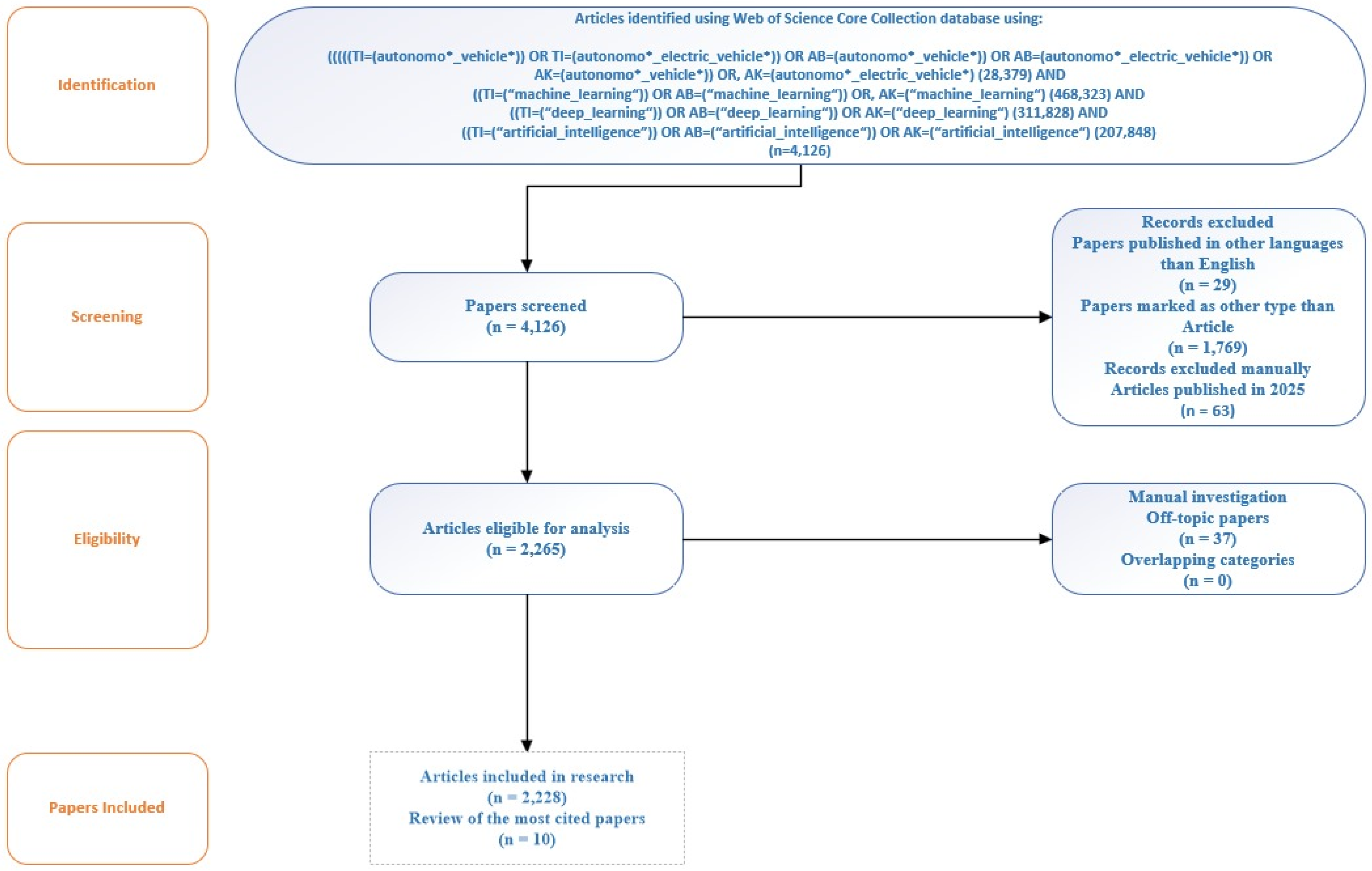
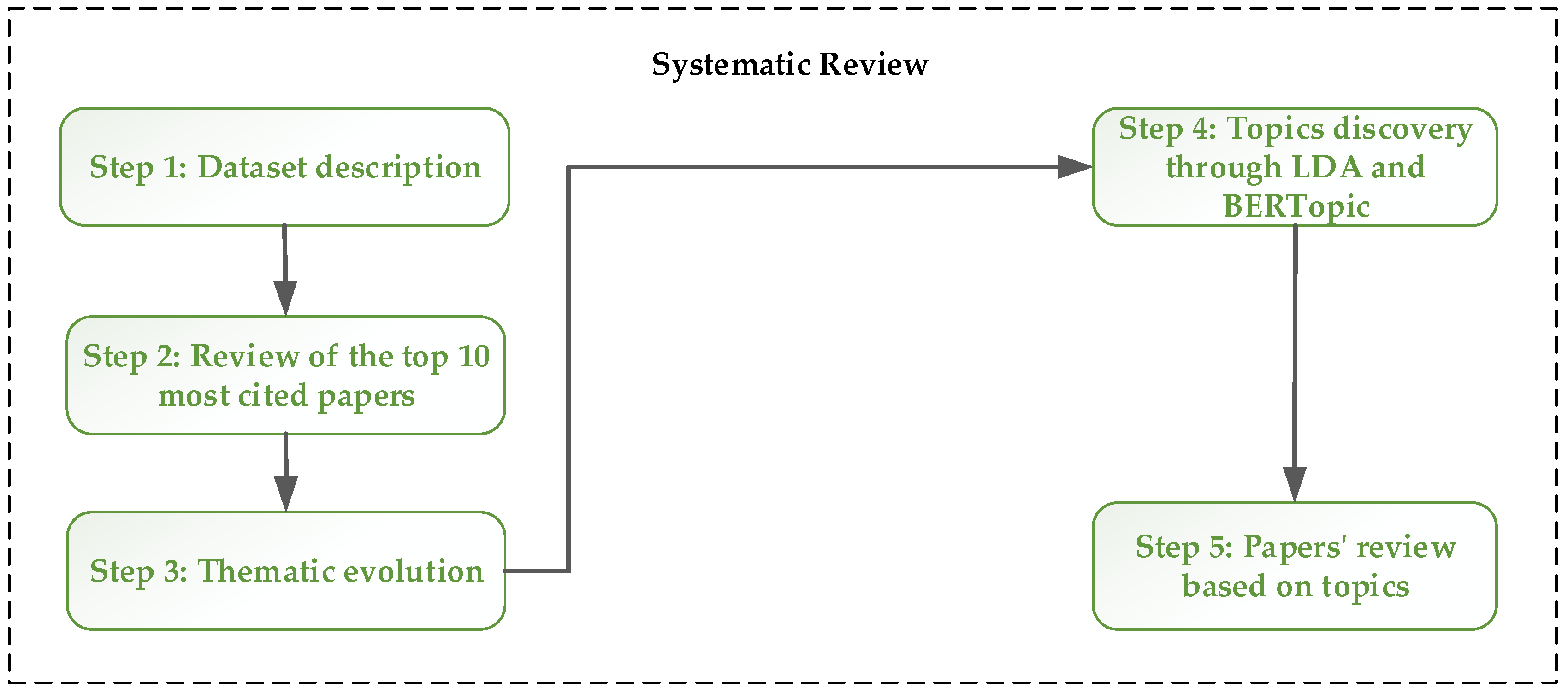



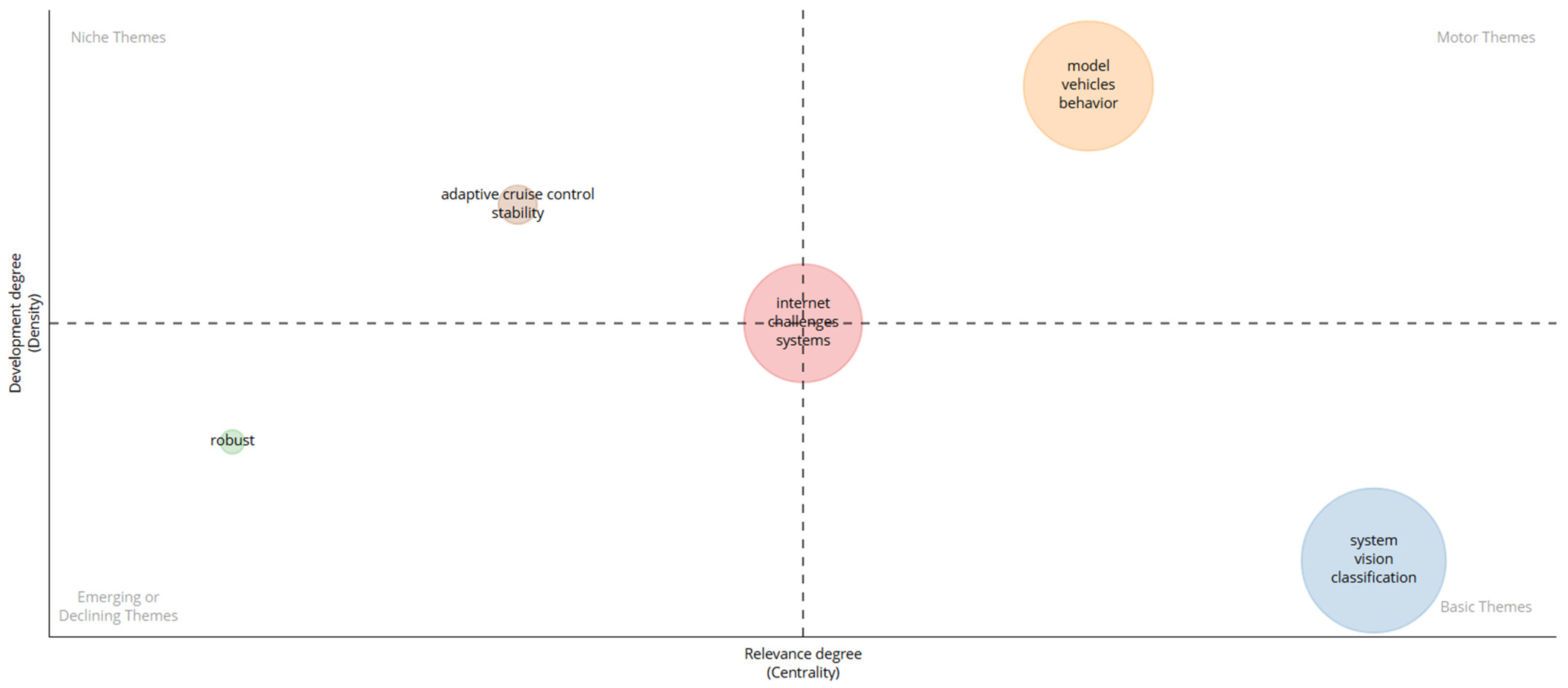

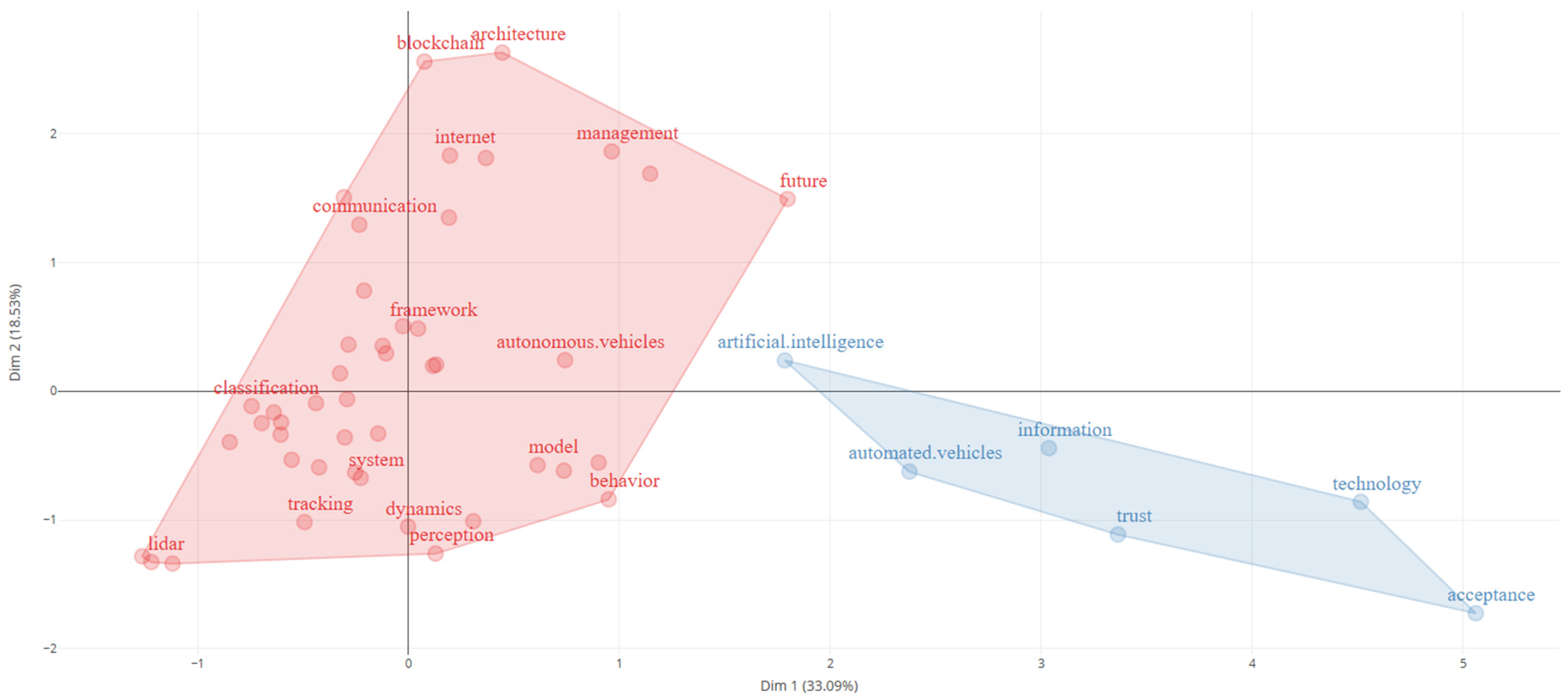




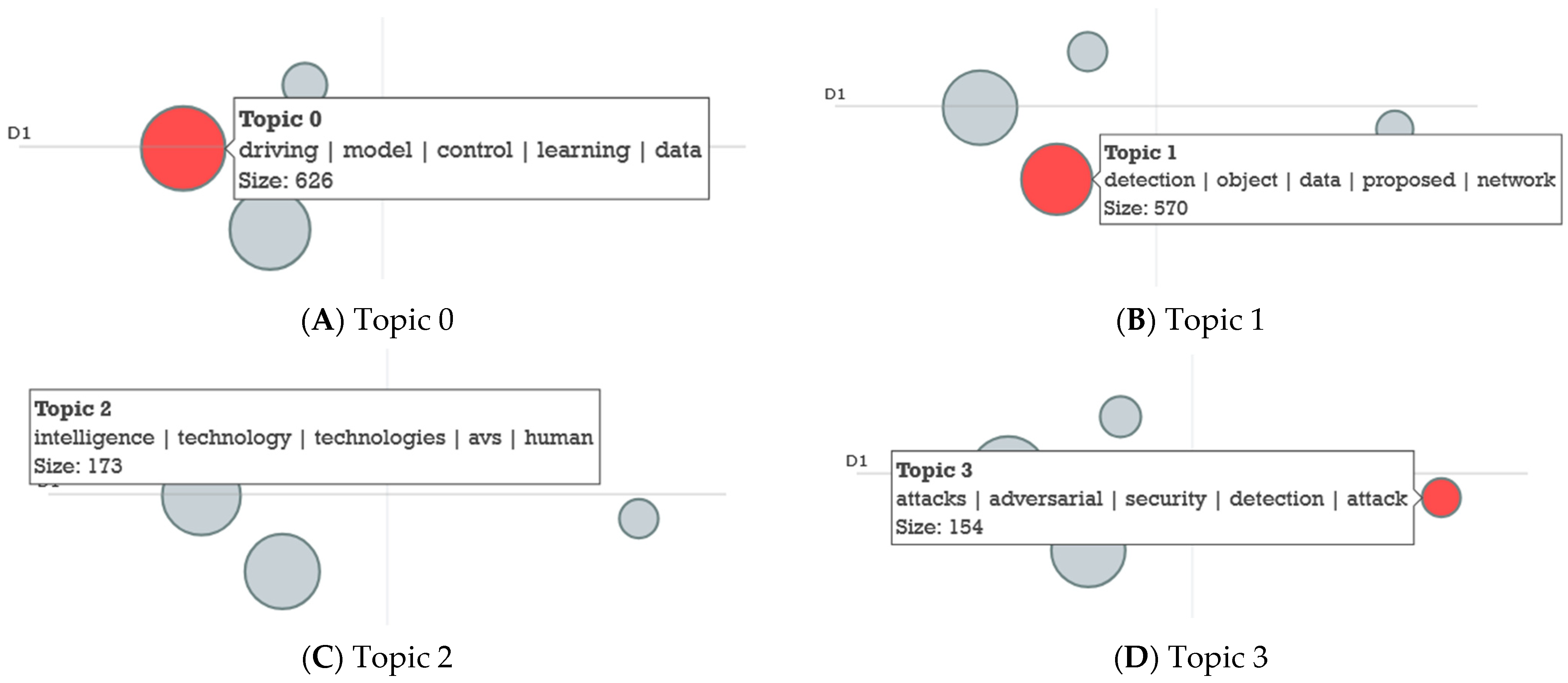
| Abbreviation | Full Term |
|---|---|
| AI | Artificial Intelligence |
| ML | Machine Learning |
| DL | Deep Learning |
| AV | Autonomous Vehicle(s) |
| LDA | Latent Dirichlet Allocation |
| BERTopic | Bidirectional Encoder Representations Topic Model |
| WoS | Web of Science |
| ANN | Artificial Neural Network |
| CNN | Convolutional Neural Network |
| RNN | Recurrent Neural Network |
| LSTM | Long Short-Term Memory |
| SLAM | Simultaneous Localization and Mapping |
| ITS | Intelligent Transportation Systems |
| Indicator | Value |
|---|---|
| Timespan | 1995–2024 |
| Sources | 617 |
| Documents | 2228 |
| Average years from publication | 2.99 |
| Average citations per documents | 19.88 |
| Co-authors per document | 4.24 |
| References | 82,070 |
| Keywords | Frequency |
|---|---|
| Keywords Plus (ID) | 1604 |
| Author’s Keywords (DE) | 5778 |
| No. | Paper (First Author, Journal, Reference) | Year | Number of Authors | Total Citations (TC) | Total Citations per Year (TCY) | Normalized Total Citations (NTC) |
|---|---|---|---|---|---|---|
| 1 | Dresner K., Journal of Artificial Intelligence Research [27] | 2008 | 2 | 836 | 46.44 | 1.00 |
| 2 | Awad E., Nature [28] | 2018 | 8 | 794 | 99.25 | 9.01 |
| 3 | Feng D., IEEE Transactions on Intelligent Transportation Systems [29] | 2021 | 8 | 683 | 136.60 | 21.02 |
| 4 | Mennel L., Nature [30] | 2020 | 6 | 676 | 112.67 | 15.06 |
| 5 | Xu XY., Nature [31] | 2021 | 12 | 601 | 120.20 | 18.50 |
| 6 | Bescos B., IEEE Robotics and Automation Letters [32] | 2018 | 4 | 597 | 74.63 | 6.77 |
| 7 | Schwarting W., Annual Review of Control, Robotics, and Autonomous Systems [33] | 2018 | 3 | 506 | 63.25 | 5.74 |
| 8 | Arnold E., IEEE Transactions on Intelligent Transportation Systems [34] | 2019 | 6 | 385 | 55.00 | 9.84 |
| 9 | Kuutti S., IEEE Transactions on Intelligent Transportation Systems [35] | 2021 | 5 | 370 | 74.00 | 11.39 |
| 10 | Koopman P., IEEE Intelligent Transportation Systems Magazine [36] | 2017 | 2 | 353 | 39.22 | 6.16 |
| No. | Paper (First Author, Journal, Reference) | Year | Title | Data | Purpose |
|---|---|---|---|---|---|
| 1 | Dresner K., Journal of Artificial Intelligence Research [27] | 2008 | A Multiagent Approach to Autonomous Intersection Management | Simulated data | To promote an alternative method for AVs movement in intersections, by considering cars and drivers as multiagent systems. AI has been used in the implementation of ITS, transforming the infrastructure into a more efficient, cheaper and safer transportation method. |
| 2 | Awad E., Nature [28] | 2018 | The Moral Machine experiment | Data collected from 40 million decisions in ten languages from 233 territories and countries | To express the concerns regarding the moral decision of AVs due to the development of AI. |
| 3 | Feng D., IEEE Transactions on Intelligent Transportation Systems [29] | 2021 | Deep Multi-Modal Object Detection and Semantic Segmentation for Autonomous Driving: Datasets, Methods, and Challenges | Car companies, visual cameras and radar datasets | To provide a solution that integrates DL and AVs for semantic segmentation and object recognition |
| 4 | Mennel L., Nature [30] | 2020 | Ultrafast machine vision with 2D material neural network image sensors | Large amount of data | To explain the impact of machine vision technology in the AVs sector by training and testing multiple sensors for image recognition |
| 5 | Xu XY., Nature [31] | 2021 | 11 TOPS photonic convolutional accelerators for optical neural networks | 500 handwritten digit images | To present the benefits of implementing ANN and CNN for image recognition that can be used in AVs sector |
| 6 | Bescos B., IEEE Robotics and Automation Letters [32] | 2018 | DynaSLAM: Tracking, Mapping, and Inpainting in Dynamic Scenes | RGB-D, public monocular and stereo datasets | To evaluate the SLAM algorithms in AVs domain and to quantify the accuracy of the models in long-term |
| 7 | Schwarting W., Annual Review of Control, Robotics, and Autonomous Systems [33] | 2018 | Planning and Decision-Making for Autonomous Vehicles | Data gathered from vehicles’ sensors | To define the emerging challenges and trends in the area of AVs, investigating safety, reliability, planning and decision-making processes |
| 8 | Arnold E., IEEE Transactions on Intelligent Transportation Systems [34] | 2019 | A survey on 3D Object Detection Methods for Autonomous Driving Applications | ImageNet and KITTI dataset | To implement AI, ML and DL in AVs sectors in order to transform the sensory data into semantic information which will help develop the autonomous driving |
| 9 | Kuutti S., IEEE Transactions on Intelligent Transportation Systems [35] | 2021 | A survey of Deep Learning Applications to Autonomous Vehicle Control | Survey Data | To develop a controller for AVs that can adapt to all complex scenarios by using DL |
| 10 | Koopman P., IEEE Intelligent Transportation Systems Magazine [36] | 2017 | Autonomous Vehicle Safety: An Interdisciplinary Challenge | Vehicles Data | To express the complexity of safety for AVs which requires a multi-disciplinary approach among ML hardware and human cooperation |
| No. | Theme | Supporting Analysis | Associated Keywords | Scope |
|---|---|---|---|---|
| 1 | Perception and Object Detection | LDA Topic 1 + BERTopic 1 + blue clusters in Figure 6 and Figure 7 | detection, object, network, segmentation, lidar, image, data, method | Deep Learning for vision, multi-sensor fusion (LiDAR, radar, cameras), semantic segmentation, SLAM, real-time object recognition |
| 2 | Driving Models, Decision-Making, and Control Systems | LDA Topic 3 + BERTopic 0 + orange/purple clusters in Figure 6 and Figure 7 | models, vehicles, safety, ML, trajectory, dynamics | Reinforcement learning, trajectory planning, vehicle control, safety in dynamic environments, intersection management |
| 3 | Human Factors, Ethics, and Societal Impact | LDA Topic 2 (partially) + BERTopic 2 + red clusters in Figure 6 and Figure 7 | intelligence, technology, human, ethical, systems, social | Public trust, ethical dilemmas (Moral Machine), societal acceptance, regulatory and policy aspects, human–AI interaction |
| 4 | Safety, Cybersecurity, and Robustness | LDA Topic 2 + BERTopic 3 + partial red clusters in Figure 6 and Figure 7 | attack, adversarial, intrusion, network, detection, resilience | Adversarial attacks on perception systems, intrusion detection, fault tolerance, system-level robustness, resilient AI architectures |
| 5 | Applications, Deployment and Technological Development | Combination of clusters not fully isolated in BERTopic but present in bibliometric thematic maps and top-cited applied studies | V2X, traffic, optimization, fleet, smart mobility, predictive maintenance | AI for V2X communication, traffic prediction, fleet management, urban integration of AVs, impact on smart cities |
Disclaimer/Publisher’s Note: The statements, opinions and data contained in all publications are solely those of the individual author(s) and contributor(s) and not of MDPI and/or the editor(s). MDPI and/or the editor(s) disclaim responsibility for any injury to people or property resulting from any ideas, methods, instructions or products referred to in the content. |
© 2025 by the authors. Licensee MDPI, Basel, Switzerland. This article is an open access article distributed under the terms and conditions of the Creative Commons Attribution (CC BY) license (https://creativecommons.org/licenses/by/4.0/).
Share and Cite
Domenteanu, A.; Diaconu, P.; Florescu, M.-S.; Delcea, C. The Road to Autonomy: A Systematic Review Through AI in Autonomous Vehicles. Electronics 2025, 14, 4174. https://doi.org/10.3390/electronics14214174
Domenteanu A, Diaconu P, Florescu M-S, Delcea C. The Road to Autonomy: A Systematic Review Through AI in Autonomous Vehicles. Electronics. 2025; 14(21):4174. https://doi.org/10.3390/electronics14214174
Chicago/Turabian StyleDomenteanu, Adrian, Paul Diaconu, Margareta-Stela Florescu, and Camelia Delcea. 2025. "The Road to Autonomy: A Systematic Review Through AI in Autonomous Vehicles" Electronics 14, no. 21: 4174. https://doi.org/10.3390/electronics14214174
APA StyleDomenteanu, A., Diaconu, P., Florescu, M.-S., & Delcea, C. (2025). The Road to Autonomy: A Systematic Review Through AI in Autonomous Vehicles. Electronics, 14(21), 4174. https://doi.org/10.3390/electronics14214174






